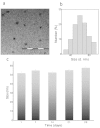The identification of goat peroxiredoxin-5 and the evaluation and enhancement of its stability by nanoparticle formation
- PMID: 27074889
- PMCID: PMC4830999
- DOI: 10.1038/srep24467
The identification of goat peroxiredoxin-5 and the evaluation and enhancement of its stability by nanoparticle formation
Abstract
An anticancer bioactive peptide (ACBP), goat peroxiredoxin-5 (gPRDX5), was identified from goat-spleen extract after immunizing the goat with gastric cancer-cell lysate. Its amino acid sequence was determined by employing 2D nano-LC-ESI-LTQ-Orbitrap MS/MS combined with Mascot database search in the goat subset of the Uniprot database. The recombinant gPRDX5 protein was acquired by heterogeneous expression in Escherichia coli. Subsequently, the anti-cancer bioactivity of the peptide was measured by several kinds of tumor cells. The results indicated that the gPRDX5 was a good anti-cancer candidate, especially for killing B16 cells. However, the peptide was found to be unstable without modification with pharmaceutical excipients, which would be a hurdle for future medicinal application. In order to overcome this problem and find an effective way to evaluate the gPRDX5, nanoparticle formation, which has been widely used in drug delivery because of its steadiness in application, less side-effects and enhancement of drug accumulation in target issues, was used here to address the issues. In this work, the gPRDX5 was dispersed into nanoparticles before delivered to B16 cells. By the nanotechnological method, the gPRDX5 was stabilized by a fast and accurate procedure, which suggests a promising way for screening the peptide for further possible medicinal applications.
Figures





Similar articles
-
The antitumor activity and preliminary modeling on the potential mechanism of action of human peroxiredoxin-5.Oncotarget. 2017 Apr 18;8(16):27189-27198. doi: 10.18632/oncotarget.16089. Oncotarget. 2017. PMID: 28423711 Free PMC article.
-
Solubility-enhanced gMYL6 fused with a hexa-lysine tag promotes the cytotoxicity of human NK cells.Immunol Lett. 2018 Jun;198:66-73. doi: 10.1016/j.imlet.2018.04.003. Epub 2018 Apr 19. Immunol Lett. 2018. PMID: 29679602
-
Comparative study of two thioredoxin peroxidases from disk abalone (Haliotis discus discus): cloning, recombinant protein purification, characterization of antioxidant activities and expression analysis.Fish Shellfish Immunol. 2008 Mar;24(3):294-307. doi: 10.1016/j.fsi.2007.11.016. Epub 2007 Dec 5. Fish Shellfish Immunol. 2008. PMID: 18226547
-
Advanced targeted therapies in cancer: Drug nanocarriers, the future of chemotherapy.Eur J Pharm Biopharm. 2015 Jun;93:52-79. doi: 10.1016/j.ejpb.2015.03.018. Epub 2015 Mar 23. Eur J Pharm Biopharm. 2015. PMID: 25813885 Review.
-
Secondary metabolites from higher fungi: discovery, bioactivity, and bioproduction.Adv Biochem Eng Biotechnol. 2009;113:79-150. doi: 10.1007/10_2008_26. Adv Biochem Eng Biotechnol. 2009. PMID: 19475376 Review.
Cited by
-
The antitumor activity of hPRDX5 against pancreatic cancer and the possible mechanisms.Braz J Med Biol Res. 2022 Sep 12;55:e12324. doi: 10.1590/1414-431X2022e12324. eCollection 2022. Braz J Med Biol Res. 2022. PMID: 36102418 Free PMC article.
-
The antitumor activity and preliminary modeling on the potential mechanism of action of human peroxiredoxin-5.Oncotarget. 2017 Apr 18;8(16):27189-27198. doi: 10.18632/oncotarget.16089. Oncotarget. 2017. PMID: 28423711 Free PMC article.
References
-
- Torre L. A. et al. Global cancer statistics, 2012. CA: a cancer journal for clinicians. 65, 87–108 (2015). - PubMed
-
- Yan Y. et al. Particle carriers for combating multidrug-resistant cancer. ACS nano. 7, 9512–9517 (2013). - PubMed
-
- J.D. Byrne T. et al. Active targeting schemes for nanoparticle systems in cancer therapeutics. Adv. Drug Deliv. Rev. 60, 1615–1626 (2008). - PubMed
-
- Wang C. et al. In vitro characterization of the anti-PD-1 antibody nivolumab, BMS-936558, and in vivo toxicology in non-human primates. Cancer immunology research. 2, 846–856 (2014). - PubMed
Publication types
MeSH terms
Substances
LinkOut - more resources
Full Text Sources
Other Literature Sources

